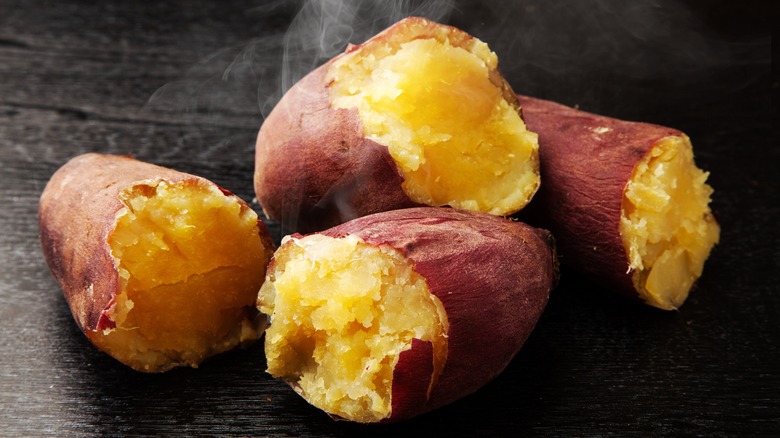Should You Really Be Eating The Skin Of Sweet Potatoes?
Be honest, do you know anyone that loves peeling the skins of sweet potatoes? Frankly, it's quite tedious work, regardless of the shade of potato. So whether you don't mind shaving the skin, or usually debate if you should, here's what you need to know about eating the skin of sweet potatoes.
For starters, sweet potatoes are extremely nutrient-dense, and this includes the skin. They're loaded with antioxidants, fiber, minerals, and vitamins. According to the U.S. Department of Agriculture (USDA), one medium-sized baked sweet potato (114 grams) with the skin is 103 calories and contains 2.29 grams of protein, 3.76 grams of fiber, and 23.6 grams of carbohydrates. Because of their nutritional content, sweet potatoes offer impressive health benefits. They promote brain, gut, and eye health, and the antioxidants give these orange tubers some cancer-fighting powers, shares Healthline. But, how does the skin compare?
Well, heavier concentrations of the minerals are found more in the skin than in the flesh of the potato. Take potassium for example. A 100-gram sweet potato with the skin has 475 milligrams of potassium, while its skinless counterpart only contains 377 milligrams (per USDA). The same principle applies to phosphorus — the skin has 54 milligrams, whereas consuming only flesh leaves you with 44 milligrams.
To peel or not to peel
Believe it or not, the skin of sweet potatoes also contain more vitamins. Skinless sweet potatoes roughly have 9.1 milligrams of vitamin C, according to the USDA. However, if you're keeping the skin on, that number significantly jumps to 19.6 milligrams (per USDA). That's nearly double the amount of vitamin C. What's even more impressive is that this orangish peel is also rich in vitamin A, vitamin E, beta carotene, and chlorogenic acid (via Healthline). Additionally, the antioxidants will help ward off free radicals and prevent damage to your cells.
Aside from being rich in vitamins, the peel is also loaded with fiber. And, if truth be told, the peel has more fiber than eating a skinless sweet potato (per USDA). In fact, one 2021 study examined this concept by comparing the fiber content of peeled and unpeeled Malaysia purple-fleshed sweet potatoes. After examining the peel condition, experts found that by losing the skin, the fiber content decreased by 63.63%. Additionally, another 2022 study reported that adding 2% of sweet potato peel powders to cookies can increase dietary fiber.
That being said, sweet potato skins are slightly more nutritious with the skin. So eat the skin raw, fry it for french fries, or mash it up with the flesh — there's an abundance of tasty ways to enjoy it.


